how many amps does a ceiling fan draw
It seems similar ceiling fans are everywhere. The funny matter is how fiddling we think nigh them until warm weather condition comes effectually when it gets uncomfortable indoors.
But just how much electricity does a ceiling fan use? How does a ceiling fan compare to floor fans, tower fans, box fans, and the other cooling fans you might take at dwelling?
To find out, I measured energy use for all of these and I've put it all together in one easy to understand guide.
Read on to detect out more.
Contents
- Infographic – Ceiling fan energy use facts
- How much electricity does a ceiling fan apply? Allow's find out
- How many watts does a ceiling fan use? My energy measurements
- How many amps does a ceiling fan use?
- Typical ceiling fan electric current draw (amps) at 120V:
- Ceiling fan vs Air conditioning comparing
- What is an AC compressor and how does air conditioning work?
- How do ceiling fans absurd a room?
- Ceiling fan vs floor fan power use
- Tower fan vs ceiling fan power use
- Ceiling fan VS tower fan ability measurements table
- Ceiling fans vs box fans
- Ceiling fan VS box fan power measurements table
- Ceiling fan vs table fan comparing
- Ceiling fan VS tabular array fan ability measurements table
- Ceiling fan wiring connections & wire color diagram
- Ceiling fan wiring colors & connections table
- Why does my ceiling fan hum?
- Electrical motors & magnetic fields
- In summary
- Suggestions for fifty-fifty more than power savings
- Effulgence and light quality matters
- Additional reading
Infographic – Ceiling fan energy utilisation facts

How much electricity does a ceiling fan use? Let's find out
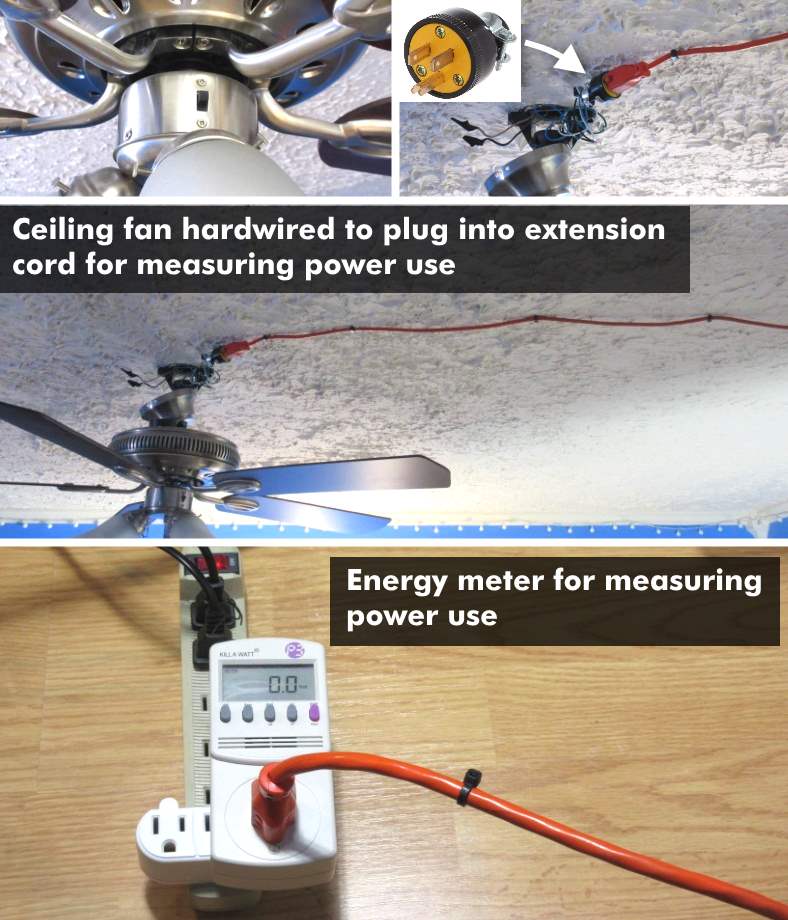
Shown: My examination setup for measuring exactly how much electricity a ceiling fan uses. In order to get you the best information, I wanted to remove Whatever guessing – and so I hardwired my 52″ ceiling fan to a ability plug and connected it to my handy Kill-A-Watt energy meter. I got slap-up measurements and finally found out what I couldn't observe anywhere else!
Considering I know that there'due south no substitute for hands-on testing, to find outexactly how much electricity a ceiling fan uses I hardwired my ceiling fan to work with an free energy meter.
What I've establish is that the trouble with many products like fans, air purifiers, and more than is:
- Only themaximum ability use is listed in the specs (non the other numbers like for depression & medium speeds)
- Energy utilisation measurements are often completely missing!
- Power use numbers are sometimes estimates,non what you'll really go far the existent world
So, I decided to find out one time and for all. To do and then, I hardwired a 52 inch 3-speed ceiling fan to an AC power outlet plug.
I then connected it to a high-quality extension cord and used my trusty Kill-A-Watt power use meter to mensurate the power use in watts.
How many watts does a ceiling fan use? My energy measurements
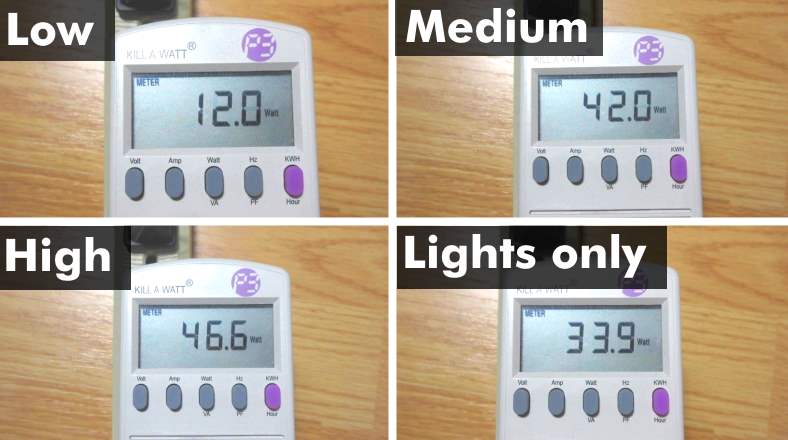
Measurements I fabricated for ceiling fan electricity use, in Watts. I honestly expected a lot more than ability to be used, but I was wrong! In fact,a ceiling fan prepare to the high speed uses less electricity than many other fans that toll less. (Annotation: When measuring merely the lights be used, the power use in watts was for 3 15W LED bulbs)
It was exciting to finallyput the question of how much electricity a ceiling fan uses to rest one time and for all. I was so tired of not being able to discover expert information anywhere just like you.
Ceiling fan power (watts) measurement table
| Fan speed or way | Power apply (Watts) |
|---|---|
| Off | 0W |
| Low | 12W |
| Medium | 42W |
| High | 46.6W |
| Lights simply (3 x 15W LED bulbs) | 33.9W |
Every bit you can see, even on the highest speed (speed 3, or "high" when pulling the fan speed selector chain) I was really surprised to see that a standard, loftier-quality 52″ ceiling fan uses less than 50 watts of ability.
Even more than astounding was how little power i uses when set up to the lowest speed: Only 12W! That'southward even less than many air purifiers and pocket-size tabular array fans I've tested.
Dandy at all!
How many amps does a ceiling fan apply?
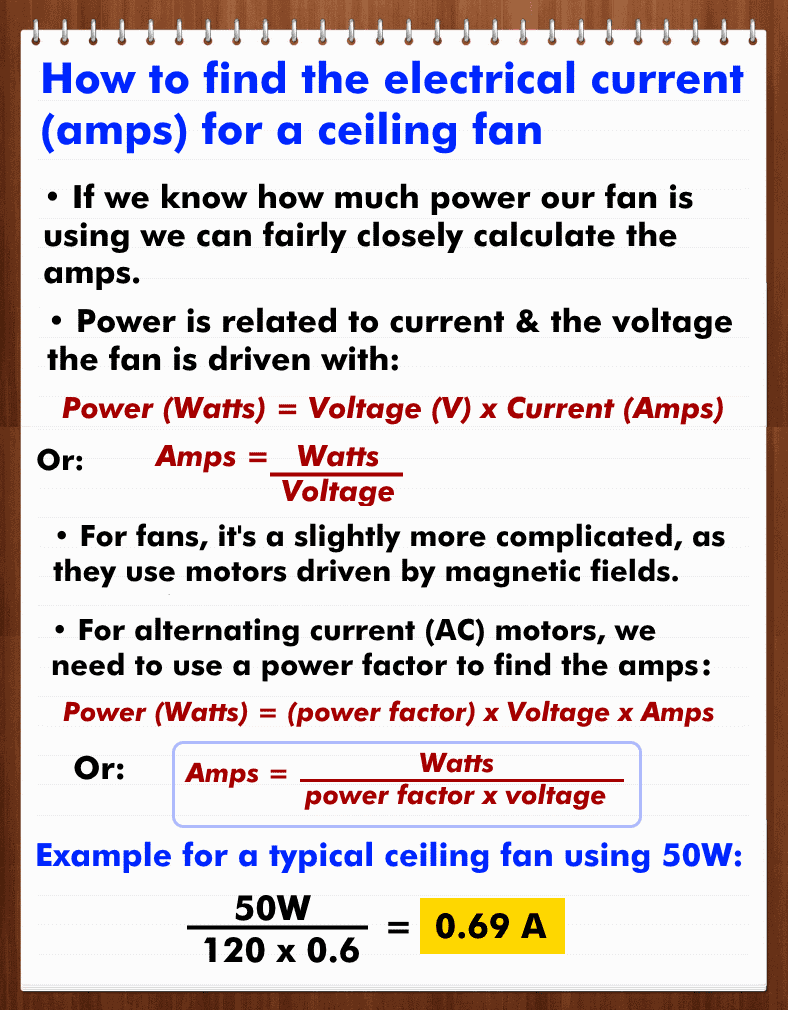
The basic formula for how to calculate ceiling fan power use in Amperes (Amps, as well written as "A"). To find out how many Amps a fan is using, nosotros tin easily get a fairly accurate number if nosotros know the power (watts) and voltage it'due south using. Since fans are "anterior" motors, information technology gets slightly more complicated, as we need to use a power factory.
Information technology's non hard to find out how many amps a ceiling fan uses. The nearly important thing is to know how much power, in Watts, the fan uses and the voltage information technology uses too. In nearly homes, that'southward around 120 volts (V).
However,since typical ceiling fans use an electric motor that works using alternating current (Ac) and magnetic fields, information technology's merely a bit more than complicated.
In that case, we need to know something called thepower factor.
Note: Some electrical testers tin measuring electrical current and make information technology easy, bold you've got a way to connect them inline with your fan. Others include the amp used in the specs sheet or characterization for the fan you own.
If not, we tin can calculate information technology on our own fairly easily and get a relatively authentic number on our own in seconds!
Direct current (DC) fans vs alternate current (Air-conditioning) fans
Some modernistic fans use a college-efficiency blueprint that changes the AC power in your dwelling to DC power using electronics congenital into the fan.
Withal, most sold today still use a standard inductive motor. Because of that, they use magnetic fields created by the AC voltage in your dwelling to turn the fan motor.
In Air-conditioning magnetic field motors some electrical current is wasted and then the motor draws more.
In this example, we use a basic number to multiply and arrange for the extra amps the fan draws. This number is called the power factor.
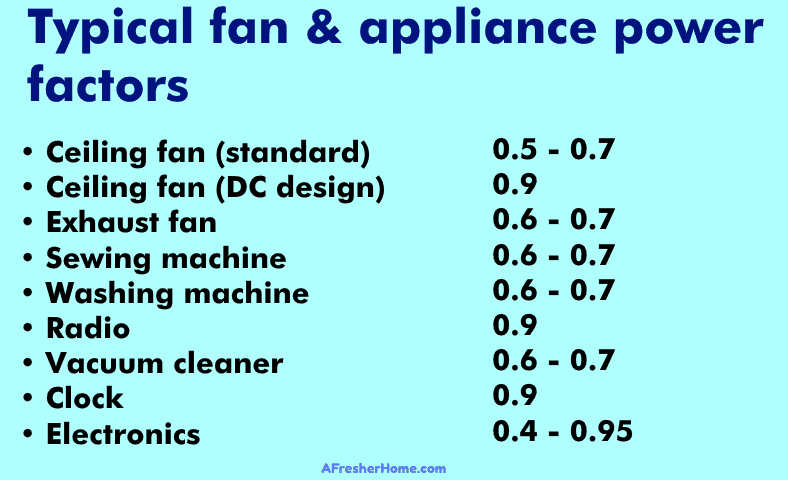
Power factors for many typical appliances including ceiling fans. The power factor is a number that describes how much electrical electric current is wasted on magnetic fields instead of power used to drive the motor. For instance, ane = 100% efficiency, while a power factor of 0.5 means an extra 50% of current is needed.
In this instance I'll use an instance ability factor value of 0.vi. Then using our simple example:
Amps = power / (power gene x voltage)
Hither's are some typical numbers showing the amps used by a ceiling fan in my home.
Typical ceiling fan current draw (amps) at 120V:
| Fan speed or manner | Power (West) | Amps (A) |
|---|---|---|
| Off | 0A | 0A |
| Low | 12 | 0.17A |
| Medium | 42 | 0.58A |
| Loftier | 46.6 | 0.65A |
Equally you can encounter, even on the highest speed a typical ceiling fan uses less than 1 amp of current. That'southward a lot less than y'all might expect! (Note: This table shows the fan used with the light bulbs turned off)
In fact, that'southward a tiny fraction of what electrical devices like heaters use (they often use 10-20 amps or more).
These are crude numbers simply most typical ceiling fans should be very close too. Even if the voltage to your ceiling is a flake less than 120V Air conditioning, the results will still be in the ballpark likewise.
Ceiling fan vs Ac comparing

As it turns out, ceiling fans use a tiny fraction of the electricity that air conditioners (Ac units) use. I measured the power draw of both to create an honest, accurate graph comparing the two so you can know what to wait.
Air conditioning (AC) units employ alotmore power than a ceiling fan.
Why? It's because while electrical fans only demand enough ability to turn the motor that spins the blades, air conditioners demand a lot of electrical power to drive an electrically powered compressorin addition to an electrical fan within.

In order to compare the two, I measured the ability draw in Watts of both. For the air conditioner'due south power apply numbers, I measured the power depict of a standard in-window small room air conditioner only like y'all might purchase for your home.
Ceiling fan VS Air conditioning power use comparison table
| Fan speed/cooling way | Ceiling fan power | AC power |
|---|---|---|
| Off | 0W | 1.2W |
| Low | 12W | 365W |
| Medium | 42W | 373W |
| High | 46.6W | 390W |
As you lot can see, a ceiling fan uses a tiny 12% of the power an air conditioner does when set to high.
If you lot're wondering why the AC unit has 1.2W of power employ when it'south turned off, it's because of the power required to keep memory settings like the last temperature y'all set and other features or controls.
For an air conditioner that uses electronic controls instead of mechanical controls, there are commonly some circuits that need backup ability even if it's non cooling a room, much like how a clock works.
What is an AC compressor and how does ac work?

Left: A home Air conditioning unit's compressor which circulates refrigerant using an electrical motor. Right: A car's AC compressor, driven past the engine and using a magnetic clutch to rotate the internal pistons when cooling is needed.
Air conditioning compressors are a critical function of an AC system, equally cooling is made possible by thermodynamics (adding or removing heat) properties that happen when a coolant gas is pressurized.
In order for an air conditioner to cool the air it must broadcast refrigerant (commonly called "freon") using a pump so these pressure level differences tin can happen.
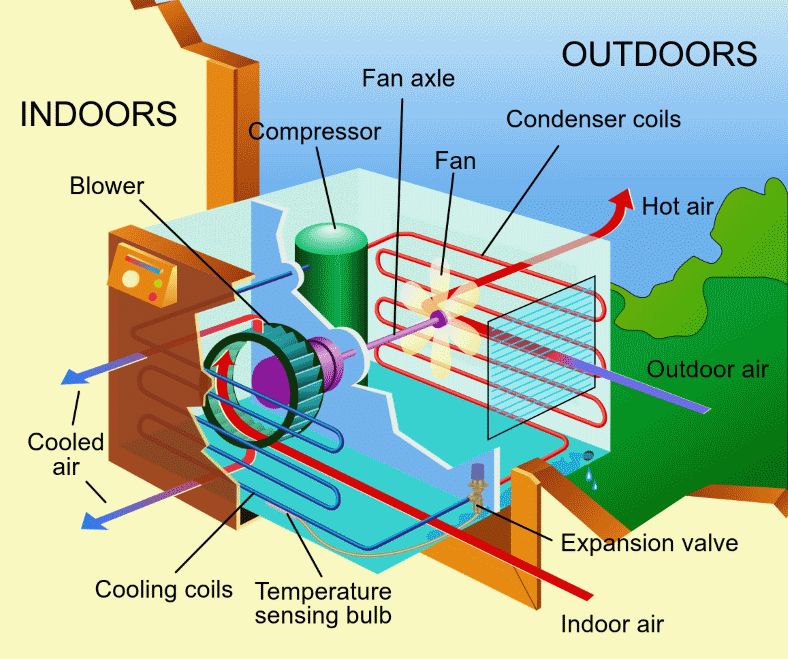
Air conditioners in your home (both window mounted and central Air conditioning systems) incorporate a series of hoses for circulating refrigerant. The compressor pumps the refrigerant, under force per unit area, which cools the air indoors by removing heat as a fan blows through information technology. The heat removed from the air indoors is forced outside as it works.
Both at dwelling house and in your car this takes a lot of free energy every bit the compressor requires a lot of force to plough the pistons it inside it.
A compressor is a type of pump that moves refrigerant inside a cooling system.
Because it's nether force per unit area (and because of the friction of its moving parts) this requires a lot of concrete strength and more electrical power. When comparison a ceiling fan vs an AC unit, in one case you lot understand the differences in what they do it's more than clear why there's such a large difference in power demands.
How practice ceiling fans cool a room?

Ceiling fans and other types of fans piece of work differently than AC systems. Instead of removing heat from the air contained in a room they directly blow air across your body & surfaces which removes rut. This results in a cooling effect.
Ceiling fans are much more efficient as they don't need the heavy electric power describe that Air-conditioning units do. They work byforced air convection cooling which means they blow air across surfaces and remove heat as the air moves.
Ceiling fan vs floor fan power employ
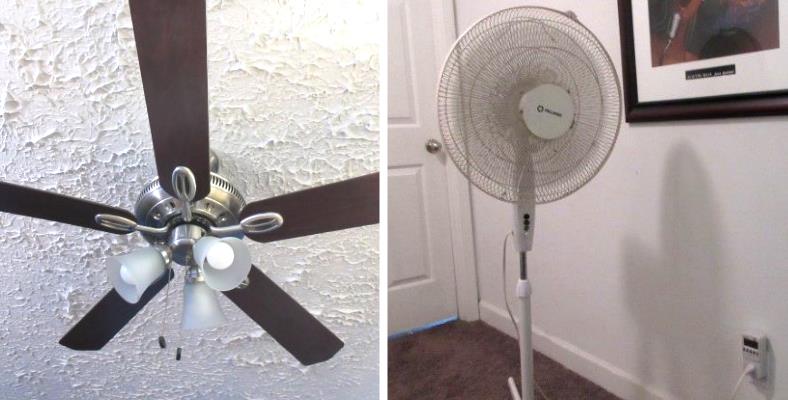
I measured the electric power utilize of a standard 3-speed oscillating flooring fan. Additionally, I measured power use both with and without the oscillating feature in utilize.
As it turns out in this case the floor fan used the aforementioned amount regardless of oscillation.
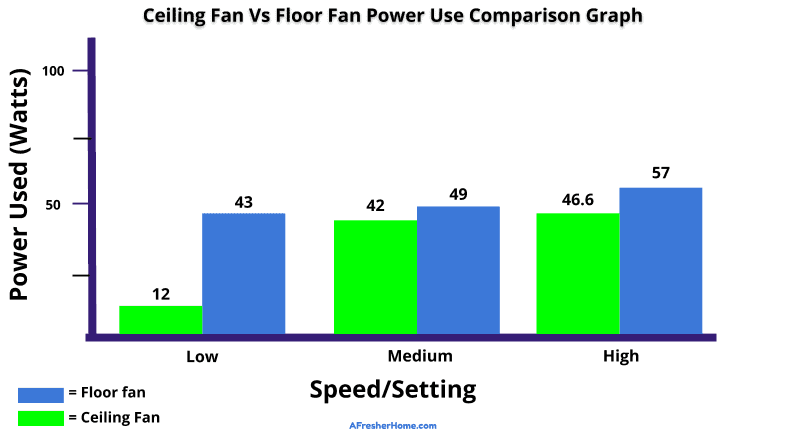
Graph showing how much electricity a ceiling fan uses compared to a floor fan. Aside from the lowest speed, they're very close in power use.
Ceiling fan VS floor fan power measurements table
| Fan speed | Ceiling fan ability | Floor fan power |
|---|---|---|
| Off | 0W | 0W |
| Low | 12W | 43W |
| Medium | 42W | 49W |
| High | 46.6W | 57W |
Both take pros and cons. For example, a floor fan is good for very powerful airflow in only a small range. For about the same amount of energy utilise, withal, a ceiling fan is ameliorate for cooling a room.
Tower fan vs ceiling fan ability use

Comparing a Honeywell QuietSet 5-speed tower fan to a ceiling fan is an interesting case. Annotation thatnot all tower fans employ the same speeds as other brands and models.
In this case, I measured the power apply of the 5-speed tower fan. Every bit it's designed to exist a quiet room fan the fan speed isn't equally high as some others.
Since comparing 3 speeds to 5 isn't exactly even I grouped the low and medium speeds to make information technology more than clear.
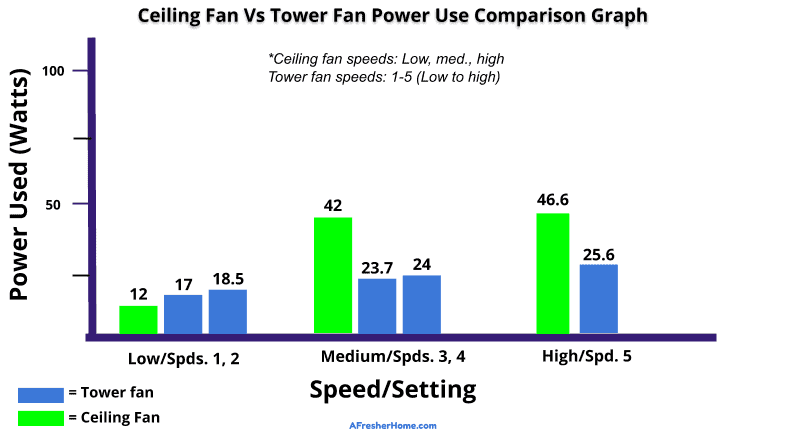
Ceiling fan VS tower fan power measurements table
| Speed | Ceiling fan | Tower fan |
|---|---|---|
| Off | 0W | 0W |
| Low | 12W | 17W, xviii.5W |
| Med. | 42W | 23.7W, 24W |
| High | 46.6W | 25.6W |
Note: Measurements are with the tower fan'south oscillation turned off. With it on measurements were 19W, 20.8W, 26W, 26.3W, and 27.7W. This means information technology adds 1-2W for oscillating motor power
As you can see, a belfry fan may use a lot less ability than a ceiling fan.
Some models like the Honeywell shown in a higher place are designed to work very quietly. Since the fan runs more quietly this affects how much power is used.
They're nice for tranquillity, gentle cooling in one specific direction while sleeping.
Ceiling fans vs box fans

Box fans are a favorite of mine considering of how much white noise they can produce. That's one advantage they have over ceiling fans.
Similar the other products in this postal service, I measured the power used past a typical box fan. What I institute was interesting – they tin can use near twice as much free energy as a ceiling fan on the high setting.

Ceiling fan VS box fan power measurements table
| Speed | Ceiling fan | Box fan |
|---|---|---|
| Off | 0W | 0W |
| Depression | 12W | 48W |
| Med. | 42W | 63.4W |
| Loftier | 46.6W | 83W |
As you lot can run into above, the disadvantage of a box fan vs a ceiling fan is the extra energy utilisation. However, for some people they're a great choice specially if you have trouble sleeping, or relaxing due to outside noises.
In that instance, the white dissonance they produce is very helpful for blocking exterior sounds while keeping you cool.
Ceiling fan vs table fan comparing
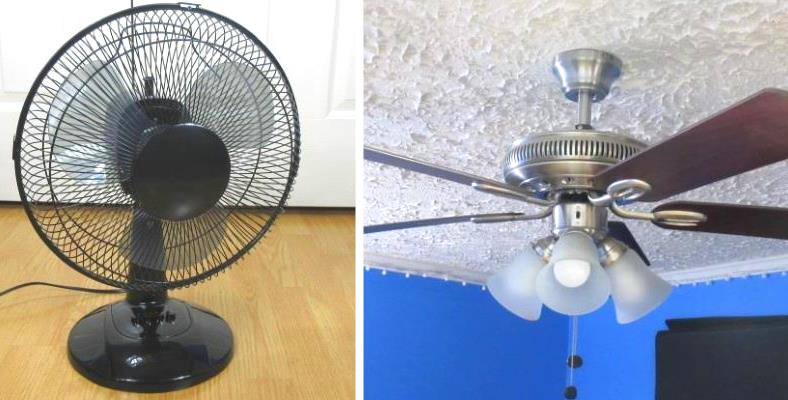
Table fans are yet another choice for cooling y'all and small areas of a room. They're often inexpensive but even so offer an oscillation feature that turns the fan side to side while bravado air.
I was curious to see if they too offered any worthwhile energy utilisation vs a ceiling fan. Here's what I found when measuring a standard 12″ table fan.
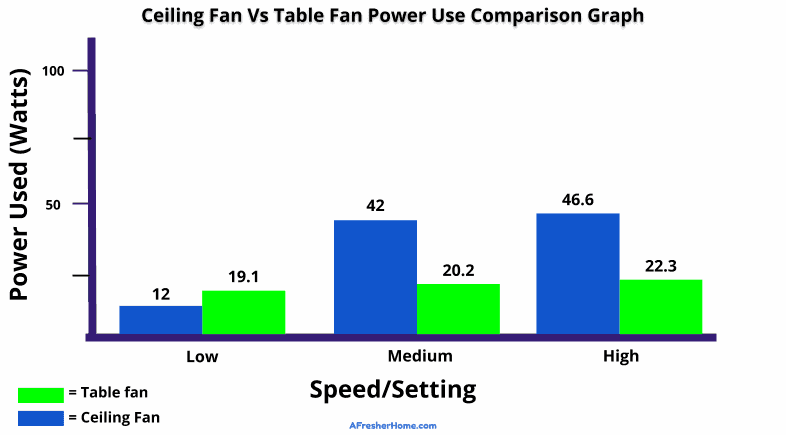
Ceiling fan VS table fan power measurements table
| Speed | Ceiling fan | Box fan |
|---|---|---|
| Off | 0W | 0W |
| Low | 12W | 19.1W |
| Med. | 42W | 20.2W |
| High | 46.6W | 22.3W |
Note: I made power measurements both with the tabular array fan'southward oscillation characteristic onand off. The power use was the same, which is bully to know (I didn't list both above as it'southward no different).
As yous tin can see, a table fan does use a lot less energy than a ceiling fan.
The tradeoff, however, is that they're only really useful for a pocket-size surface area such as most your bed, near a desk, piece of work table, and then on.
They do also give a small amount of white noise which is dainty. It'southward not equally effective as that from a box fan, but it's worth because.
Still, again if cooling the room is your goal then a ceiling fan is still a better option.
Ceiling fan wiring connections & wire color diagram

Click on the image to view the original/zoom or click below to download a copy
Ever wondered how hard it is to connect a ceiling fan or how they get their power? As it turns out, they're actually not very complicated in terms of wiring.
They're virtually equally unproblematic to wire up as calorie-free fixtures in your home. In fact, I've added new ceiling fans as you can install them in the place of a low-cal fixture.
Many homes have metal boxes pre-installed in the ceiling where it'southward possible to notice wiring ready to connect and mount a ceiling fan base also if needed.
As you can encounter in the diagram I've provided, there are typically only about 4 wires needed for ceiling fan power connections.
Ceiling fan wiring colors & connections tabular array
| Fan wire color | Description |
|---|---|
| Blackness | 120V power "hot" wire for the fan motor circuit. Connects to home'due south black (hot) wire |
| White | Neutral power return wire. Connects to white neutral (render ability) wire |
| Blue | Fan light excursion power. Connects to the black supply wire |
| Green / Lt green | If present (or some other color), connects to the abode's basis wire. Some fans besides have a ground wire on the mounting base of operations to connect. |
Ultimately information technology depends on the particular fan and so call up the wiring colors listed here are just examples of my ain. Always double-check the installation instructions to be certain.
In my case, the footing wire had its own label fastened.
Why does my ceiling fan hum?
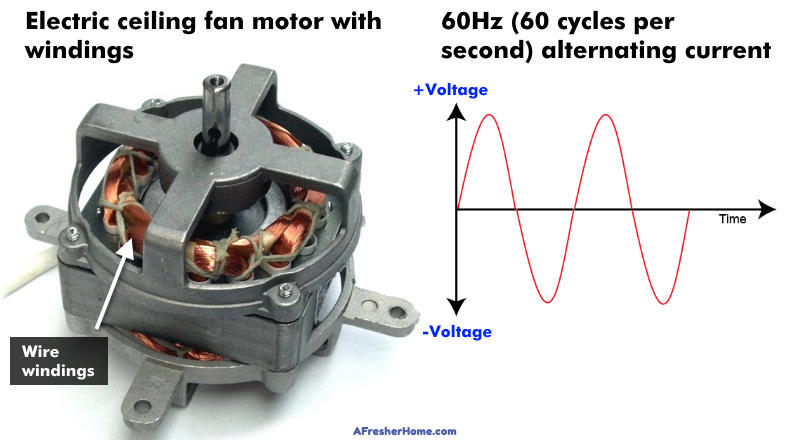
Electric fan motors incorporate a huge amount of copper wire windings inside. These windings create magnetic fields that plough the fan rotor (the central rotating part within the motor) and spin the fan blades. Alternate current (Ac) from your home's electrical system changes direction constantly at lx times per second (threescore Hertz per second) and can cause a humming sound.
Electric fans of many kinds, including ceiling fans, are subject to a mild bustling sound you lot may notice.
Information technology's a very common side result of the type of electrical power supply that homes apply. As fourth dimension goes by it tin really increase in volume as a fan and its parts historic period. That'due south considering the tiny vibrations move components over time and parts tin can lose the resistance to vibration they had when new.
Air conditioning ability is in the range of human hearing
The sixty Hertz (Hz) frequency for the alternating current (AC) power supply in your habitation is within the range of audio your ears can hear. In fact, Air conditioning current produces a "humming" sound in the range of bass you lot sometimes hear in music.
It's especially common in fans like box fans. They're more prone to vibrating and more likely to create a humming sound that's easy to hear.
In some situations, the fan's humming vibration due to the power source can transfer through surrounding ceiling parts and the sound can carry further, making it even more pronounced.
Electrical motors & magnetic fields
Electric motors rely on magnetic fields created when electricity flows through copper wire windings. This creates a magnetic force that turns the central part of the motor chosen a rotor.
The rotor is fastened to a spindle that the fan blades are mounted on and spin from in that location.
These magnetic fields, which alter direction lx times per second, tin can cause fan parts to move quickly and therefore create a humming sound your ears tin hear.
It's also why when you're close to outdoor power transformers used by the ability company (or other electrical devices) you may hear a hum there besides.
In summary

To summarize the electrical power use and pros & cons of ceiling fans, let'due south review what I've covered here today.
As you tin can encounter from the power use I measured, they'revery reasonable in how much electricity they employ. That'southwardespecially truthful when compared to how much an AC unit uses!
They exercise take pros and cons though, of form. While they're good for cooling a whole room (and pay for themselves in just a few months as compared to air conditioners) they aren't good for white noise or for cooling an exact area of you or your room.
Overall, all the same, they're a cracking choice.
Suggestions for fifty-fifty more than ability savings

To keep free energy costs low and notwithstanding become good quality lighting, cull an energy-efficient LED seedling with good effulgence output level (measured in Lumens).
For best results, I recommend using good quality LED bulbs that produce low-cal that'south easy on your optics. These days y'all can find high-brightness LED bulbs that work well in ceiling fans and consume 15W or less.
Compared to the ability apply of incandescent bulbs of years gone past (45W, 60W, and fifty-fifty 100W) that's abig energy saving!
Brightness and light quality matters
Many offer several choices of color "temperature" (the yellow or white tint they produce) and brightness. I recommend getting bulbs with enough brightness, measured in Lumens.
Personally, I recommend bulbs with a lumens rating of 800 or higher, although you can find some putting out 1,200 or even ane,500 with only 15W power utilise if you shop carefully.
These days good LED bulbs can be found for around $three-$x each or in majority quantities for even more savings. Avoid the absolute cheapest bulbs equally they accept higher failure rates and tend to have a poor light quality that isn't good for your eyes.
Cheap bulbs likewise have poor color rendering which means that colors won't await natural or appear as well as they should.
Additional reading
Considering a box fan instead of a ceiling fan considering yous need white racket? Have a wait at my great mail service with some of the best box fans for white noise here.
Need a tranquility, gentle tower fan that won't disturb you? Here'southward a helpful list of some of the best tower fans for cooling.
Source: https://afresherhome.com/how-much-electricity-ceiling-fan-use-guide/
Posted by: smithealaings.blogspot.com


0 Response to "how many amps does a ceiling fan draw"
Post a Comment